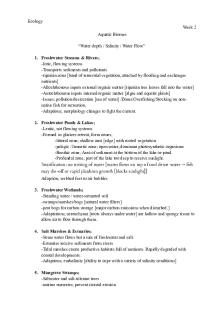Gaelic society- week 2 - lecture notes- Scotland PDF

| Title | Gaelic society- week 2 - lecture notes- Scotland |
|---|---|
| Author | Ellie Dolman |
| Course | The Pursuit of History |
| Institution | University of Wolverhampton |
| Pages | 2 |
| File Size | 53.5 KB |
| File Type | |
| Total Downloads | 48 |
| Total Views | 122 |
Summary
lecture notes- Scotland...
Description
Gaelic society: An Introduction To understand the Highland clans we must appreciate the society and culture in which they operated.
The clans existed throughout the north and west of Scotland centuries between approximately 1200 and 1800. They were also Scots Gaelic speaking. Gaelic as the Gàidhealtachd. Usually by its geographic label of the Highlands and Islands. Region encompasses the central and western areas of the north of Scotland and the Inner and Outer Hebrides.
The historic Gàidhealtachd
Covered over 40% of Scotland’s landmass Still characterised by a remarkable diversity of landscapes and environments. There are the flat, sandy, machair lands of islands; such as South and North Uist in the Outer Hebrides, and fertile farming zones in districts like Kintyre and the Isle of Islay in Argyll.
The ‘Highlands’
Hides a wide range of land and seascapes Soil types and settlement potential. The clans reflected this diversity. Physical environment is challenging, both now and then. The bulk of the land lies above 250 metres and is mostly rough grazing with only limited arable capacity. Under such conditions crop production is limited Cattle rearing a vital source of food and wealth. Climate compounds these geographic constraints. Heavy amounts of rain, winter storms, and a constricted, unreliable growing season.
Perceptions of the Gàidhealtachd
Between1350 and 1950 Many cultural commentators portrayed this part of Scotland as geographically isolated. As poverty stricken, disloyal, disorderly, and barbarous. Crude stereotyping fails to grasp the sophistication of the clans; their delicate and complex social hierarchy, and the uniqueness and beauty of their learning, language, art and song.
The Gàidhealtachd
Cultural region within the Scottish and later British kingdoms. Through literary forms of Gaelic (known as Classical Gaelic) it maintained a dense set of linguistic, political, military and diplomatic links with Ireland for centuries. This part of Scotland had an ‘arms-length’ relationship with the Lowlands, there was nevertheless much cultural and political interaction.
The Macdonald Lords of the Isles
From the late twelfth century onwards; Clan Donald Lords of the Isles rose to dominate the Inner and Outer Hebrides And the west coast of the Highlands.From their power base in Finlaggan on Islay, successive Lords of the Isles issued laws and regulated the various subordinate clans. They presided over a flourishing of classical Gaelic learning and art
They acted as patrons of extended family groups like the Beatons Who specialized in medical knowledge, and the MacMhuirichs, and provided bards (poets) and advisers. This was an expansive and confident society.
Civil war
Ensued and political and military instability spread across the Gàidhealtachd. Key western clans such as the Macleans, Macleods and Macneils, supported Lord John. Major branches of Clan Donald, such as Clanranald, Keppoch, and Sleat, backed Angus. Arguably, it was the growing failure to ensure peace and stability, rather than any innate antiGaelic policy, which led King James the Fourth in 1493 to order the final forfeiture of the Lordship....
Similar Free PDFs

Week 2 Lecture Notes
- 5 Pages

WEEK 2 - Lecture notes 2
- 5 Pages

Week 2 - Lecture notes 2
- 7 Pages

Week Two - Lecture notes 2
- 9 Pages

Lecture Notes Week 2 1014CCJ
- 7 Pages

Media and Society Lecture Notes
- 4 Pages

WEEK 2 ACCY112 - Lecture notes 2
- 3 Pages

NSE 13 week 2 - Lecture notes 2
- 5 Pages
Popular Institutions
- Tinajero National High School - Annex
- Politeknik Caltex Riau
- Yokohama City University
- SGT University
- University of Al-Qadisiyah
- Divine Word College of Vigan
- Techniek College Rotterdam
- Universidade de Santiago
- Universiti Teknologi MARA Cawangan Johor Kampus Pasir Gudang
- Poltekkes Kemenkes Yogyakarta
- Baguio City National High School
- Colegio san marcos
- preparatoria uno
- Centro de Bachillerato Tecnológico Industrial y de Servicios No. 107
- Dalian Maritime University
- Quang Trung Secondary School
- Colegio Tecnológico en Informática
- Corporación Regional de Educación Superior
- Grupo CEDVA
- Dar Al Uloom University
- Centro de Estudios Preuniversitarios de la Universidad Nacional de Ingeniería
- 上智大学
- Aakash International School, Nuna Majara
- San Felipe Neri Catholic School
- Kang Chiao International School - New Taipei City
- Misamis Occidental National High School
- Institución Educativa Escuela Normal Juan Ladrilleros
- Kolehiyo ng Pantukan
- Batanes State College
- Instituto Continental
- Sekolah Menengah Kejuruan Kesehatan Kaltara (Tarakan)
- Colegio de La Inmaculada Concepcion - Cebu







